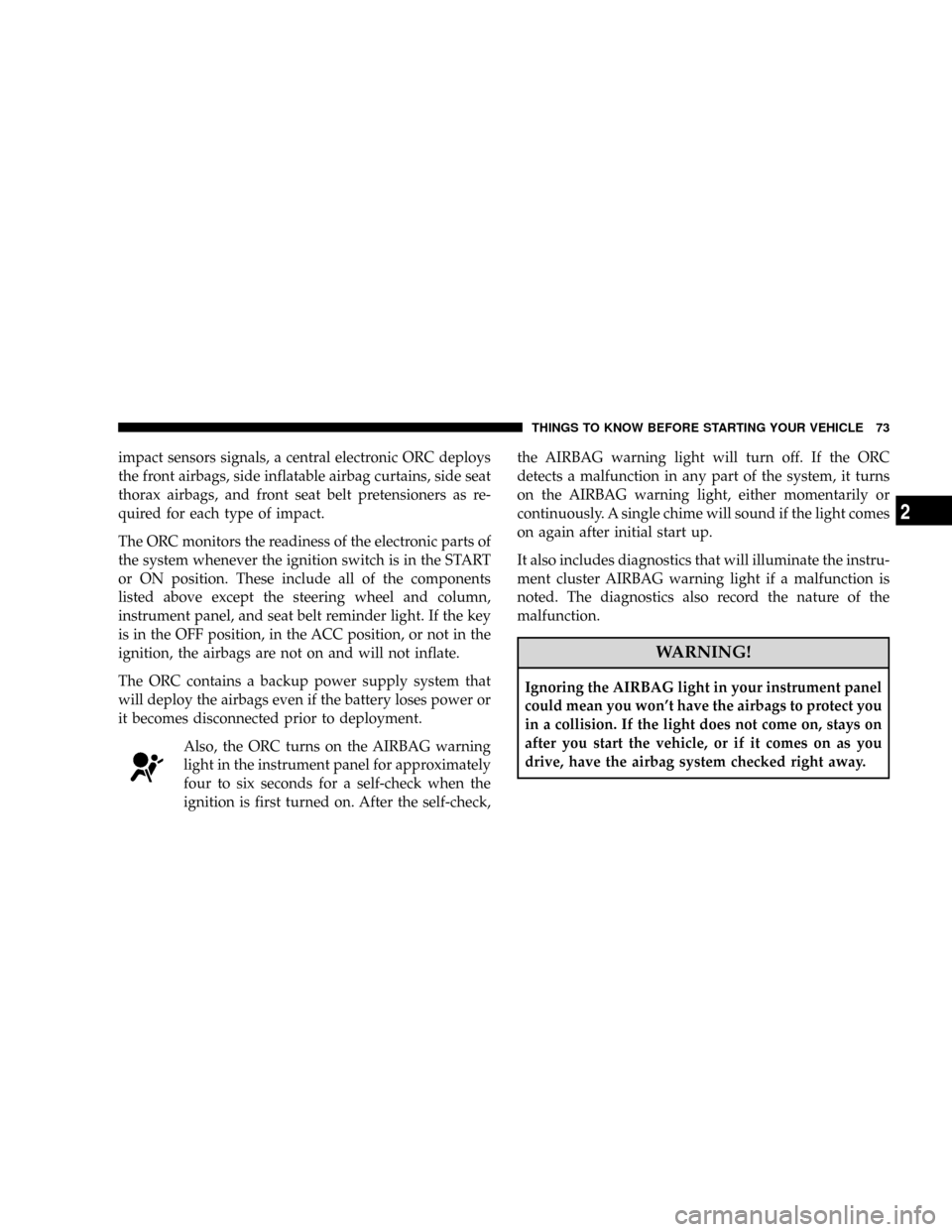Page 15 of 531
The valet key allows for entry into the vehicle should the
battery in the vehicle or the transmitter go dead. The
valet key is also for locking the glove box. You can keep
the valet key with you when valet parking.
To remove the valet key from the transmitter, slide the
mechanical latch at the top of the transmitter sideways
with your thumb and then pull the key out with your
other hand.
NOTE:You can insert the double-sided valet key into
the lock cylinder with either side up.
Tip Start Feature
1. Do not press the accelerator pedal during this process.
Valet Key Removal
THINGS TO KNOW BEFORE STARTING YOUR VEHICLE 13
2
Page 22 of 531

previously described arming sequences has occurred, the
system will arm regardless of whether you are in the
vehicle or not. If you remain in the vehicle and open a
door, the alarm will sound. If this occurs, disarm the
system.
If the Security Alarm System is armed and the battery
becomes disconnected, the system will remain armed
when the battery is reconnected; the exterior lights will
flash, the horn will sound, and the ignition will not start
the vehicle. If this occurs, disarm the system.
Tamper Alert
If something has triggered the system in your absence,
the horn will sound three times when you unlock the
doors and the security telltale light will flash for 30
seconds. Check the vehicle for tampering.
Security System Manual Override
The system will not arm if you lock the doors using the
manual door lock plunger.
ILLUMINATED ENTRY SYSTEM Ð IF EQUIPPED
The courtesy lights will turn on when you use the
Remote Keyless Entry (RKE) transmitter or open the
doors. This feature is only available if you have RKE.
The lights will fade to off after approximately 10 seconds
or they will immediately fade to off once the ignition
switch is turned ON.
NOTE:
²The front courtesy overhead console, door courtesy
and liftgate lights do not turn on if the dimmer control
is in the interior lights ON position (extreme top
position).
²The Illuminated Entry System will not operate if the
dimmer control is in the extreme downward position.
20 THINGS TO KNOW BEFORE STARTING YOUR VEHICLE
Page 28 of 531
The table below explains the Lamp Flash options.
FunctionWhich Turn
Signal LampsNumber of
Flashes
Lock All 1
Unlock 1st Press Left Side 2
Unlock All
DoorsAll 2
Left Side Left Side 2
Right Side Right Side 2
Liftgate All 2
Programming Additional RKE Transmitters
Refer to Sentry KeytImmobilizer System ªCustomer
Key Programming.º
If you do not have a programmed RKE transmitter,
contact your authorized dealer for details.
Replacing the RKE Transmitter Battery
The recommended replacement battery is one CR2032
battery.
NOTE:
Perchlorate Material Ð special handling may ap-
ply. See: www.dtsc.ca.gov/hazardouswaste/perchlorate.
NOTE:Do not touch the battery terminals that are on
the back housing or the printed circuit board.
1. Battery access is through a door located on the rear of
the RKE transmitter. Insert a small, flat bladed screw-
driver into the slot and gently pry open the access door.
26 THINGS TO KNOW BEFORE STARTING YOUR VEHICLE
Page 29 of 531
2. Remove and replace the battery. Avoid touching the
new battery with your fingers. Skin oils may cause
battery deterioration. If you touch the battery, clean it
with rubbing alcohol.
3. Reposition the access door panel over the battery
opening and snap into place.
General Information
This device complies with part 15 of the FCC rules and
RSS 210 of Industry Canada. Operation is subject to the
following conditions:
²This device may not cause harmful interference.
²This device must accept any interference received,
including interference that may cause undesired op-
eration.
If your RKE transmitter fails to operate from a normal
distance, check for these two conditions.
1. A weak battery in the RKE transmitter. The expected
life of the battery is a minimum of three years.
2. Closeness to a radio transmitter such as a radio station
tower, airport transmitter, and some mobile or CB radios.
Battery Replacement
THINGS TO KNOW BEFORE STARTING YOUR VEHICLE 27
2
Page 30 of 531
REMOTE STARTING SYSTEM Ð IF EQUIPPED
Remote Starting conveniently starts the engine from
outside the vehicle by using the Remote Keyless Entry
(RKE) transmitter while maintaining the Security Alarm
System. The Remote Starting System has a targeted range
of 328 ft (100 m). In order to Remote Start your vehicle,
the hood, liftgate, and all the doors must be closed and
the transmission gear selector lever in PARK.
NOTE:Remote Starting requires automatic transaxle-
equipped vehicles.
How To Use Remote Start
All of the following conditions must be met before the
engine will Remote Start:
²Gear shift lever in PARK
²Doors closed
²Hood closed
²Trunk closed
²HAZARD switch off
²BRAKE switch inactive (brake pedal not pressed)
²Ignition key removed from ignition switch
²Battery at an acceptable charge level, and
²RKE PANIC button not pressed.
28 THINGS TO KNOW BEFORE STARTING YOUR VEHICLE
Page 75 of 531

impact sensors signals, a central electronic ORC deploys
the front airbags, side inflatable airbag curtains, side seat
thorax airbags, and front seat belt pretensioners as re-
quired for each type of impact.
The ORC monitors the readiness of the electronic parts of
the system whenever the ignition switch is in the START
or ON position. These include all of the components
listed above except the steering wheel and column,
instrument panel, and seat belt reminder light. If the key
is in the OFF position, in the ACC position, or not in the
ignition, the airbags are not on and will not inflate.
The ORC contains a backup power supply system that
will deploy the airbags even if the battery loses power or
it becomes disconnected prior to deployment.
Also, the ORC turns on the AIRBAG warning
light in the instrument panel for approximately
four to six seconds for a self-check when the
ignition is first turned on. After the self-check,the AIRBAG warning light will turn off. If the ORC
detects a malfunction in any part of the system, it turns
on the AIRBAG warning light, either momentarily or
continuously. A single chime will sound if the light comes
on again after initial start up.
It also includes diagnostics that will illuminate the instru-
ment cluster AIRBAG warning light if a malfunction is
noted. The diagnostics also record the nature of the
malfunction.
WARNING!
Ignoring the AIRBAG light in your instrument panel
could mean you won't have the airbags to protect you
in a collision. If the light does not come on, stays on
after you start the vehicle, or if it comes on as you
drive, have the airbag system checked right away.
THINGS TO KNOW BEFORE STARTING YOUR VEHICLE 73
2
Page 77 of 531

²Turns on the interior lights, which remain on as long as
the battery has power or until the ignition key is
removed.
²Unlocks the doors automatically.
If A Deployment Occurs
The airbag systems are designed to deploy when the
Occupant Restraint Controller (ORC) detect a moderate-
to-severe collision, to help restrain the driver, front
passenger and rear passengers, and then immediately
deflate.
NOTE:A frontal collision that is not severe enough to
need airbag protection will not activate the system. This
does not mean something is wrong with the airbag
system.If you do have a collision which deploys the airbags, any
or all of the following may occur:
²The nylon airbag material may sometimes cause abra-
sions and/or skin reddening to the driver and front
passenger as the airbags deploy and unfold. The
abrasions are similar to friction rope burns or those
you might get sliding along a carpet or gymnasium
floor. They are not caused by contact with chemicals.
They are not permanent and normally heal quickly.
However, if you haven't healed significantly within a
few days, or if you have any blistering, see your doctor
immediately.
²As the airbags deflate, you may see some smoke-like
particles. The particles are a normal by-product of the
process that generates the nontoxic gas used for airbag
inflation. These airborne particles may irritate the skin,
eyes, nose, or throat. If you have skin or eye irritation,
rinse the area with cool water. For nose or throat
THINGS TO KNOW BEFORE STARTING YOUR VEHICLE 75
2
Page 80 of 531

located on the inside of the fuse block cover for the
proper airbag fuses. See your authorized dealer if the
fuse is good.
Event Data Recorder (EDR)
In the event of an accident, your vehicle is designed to
record up to approximately five seconds of specific
vehicle data parameters (see the following list) in an
event data recorder prior to the moment of airbag de-
ployment, or near deployment, and up to a quarter-
second of high-speed deceleration data during and/or
after airbag deployment. EDR data are ONLY recorded if
an airbag deploys, or nearly deploys, and are otherwise
unavailable.
NOTE:
1. A near-deployment event occurs when the airbag
sensor detects severe vehicle deceleration usually indica-
tive of a crash, but not severe enough to warrant airbag
deployment.2. Under certain circumstances, EDR data may not be
recorded (e.g., loss of battery power).
In conjunction with other data gathered during a com-
plete accident investigation, the electronic data may be
used by DaimlerChrysler Corporation and others to learn
more about the possible causes of crashes and associated
injuries in order to assess and improve vehicle perfor-
mance. In addition to crash investigations initiated by
DaimlerChrysler Corporation, such investigations may
be requested by customers, insurance carriers, govern-
ment officials, and professional crash researchers, such as
those associated with universities, and with hospital and
insurance organizations.
In the event that an investigation is undertaken by
DaimlerChrysler Corporation (regardless of initiative),
the company or its designated representative will first
obtain permission of the appropriate custodial entity for
the vehicle (usually the vehicle owner or lessee) before
78 THINGS TO KNOW BEFORE STARTING YOUR VEHICLE